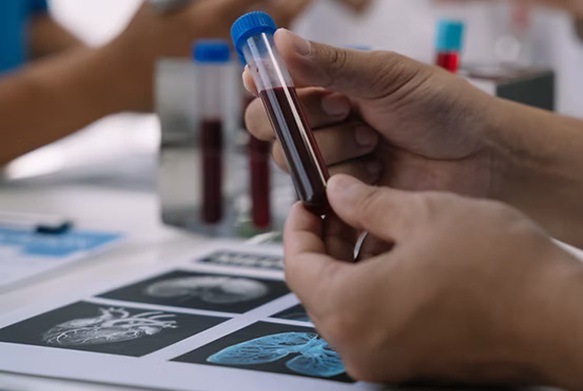AI Algorithm Listens To Patients Pass Urine for Assessing Urinary Tract Symptoms
|
By LabMedica International staff writers Posted on 05 Jul 2022 |

Lower urinary tract symptoms, problems related to the working of the bladder and the urethra, are common and affect an estimated 60% of men and 57% of women. Uroflowmetry is an important tool for the assessment of patients with symptoms, but patients have to urinate into a machine during outpatient visits. They are asked to urinate into a funnel connected to the uroflowmeter which records information about flow. During the COVID-19 pandemic access to clinics has been restricted, and even where patients can attend, the test can take a long time with queues to use a single machine. Now, an artificial intelligence (AI) algorithm trained to listen to patients pass urine can identify abnormal flows and could be a useful and cost-effective means of monitoring and managing urology patients at home.
The deep learning tool, Audioflow, that was developed by researchers at the Singapore General Hospital (Singapore) performed almost as well as a specialist machine used in clinics, and achieved similar results to urology residents in assessing urinary flow. The current study focused on sound created by urine in a soundproof environment, but the ambition is to create an app so patients can monitor themselves at home. In order to train and validate the algorithm, the researchers recruited 534 male participants between December 2017 and July 2019 to it. Participants used the usual uroflowmetry machine in a soundproofed room, and recorded their urination using a smartphone.
Using 220 recordings, the AI learned to estimate flow rate, volume, and time which can indicate when there is an obstruction or if the bladder is not working well. It was trained to listen to and analyze male urinary flow which is different from that of women and would need a separate sample to learn to analyze female urination. The results were compared to a conventional uroflowmetry machine and to a panel of six urology residents who separately graded the dataset. The AI agreed with conventional uroflowmetry for over 80% of recordings, and compared to the specialist urologists and external residents for identification of abnormal flows, it achieved an 84% rate of agreement. Audioflow will now be rolled out as a smartphone app via primary care physicians so it can be tested in the real world and learn from different datasets in different noise environments.
“There is a trend towards using machine learning in many fields, because clinicians do not have a lot of time. At the same time, particularly since the pandemic there is a shift towards telemedicine and less hospital-based care. We were keen to develop a way to monitor our patients to see how they are doing between hospital visits,” said Dr. Lee Han Jie from the Singapore General Hospital who led the development of the algorithm. “Our AI can outperform some non-experts and comes close to senior consultants. But the real benefit is having the equivalent of a consultant in the bathroom with you, every time you go. We are now working towards the algorithm being able to work when there is background noise in the normal home environment and this will make the true difference for patients.”
“Giving patients the ability to measure urinary flow at home is more comfortable for them and reduces time waiting in the clinic,” said Christian Gratzke, Professor of Urology at University Hospital Freiburg and member of the EAU22 Scientific Congress Committee of Urology. “This is a well-executed study with a significant number of patients and represents a promising approach to developing a portable app that can be used at home. I look forward to seeing the real-world results.”
Related Links:
Singapore General Hospital
Latest Technology News
- Disposable Microchip Technology Could Selectively Detect HIV in Whole Blood Samples
- Pain-On-A-Chip Microfluidic Device Determines Types of Chronic Pain from Blood Samples
- Innovative, Label-Free Ratiometric Fluorosensor Enables More Sensitive Viral RNA Detection
- Smartphones Could Diagnose Diseases Using Infrared Scans
- Novel Sensor Technology to Enable Early Diagnoses of Metabolic and Cardiovascular Disorders
- 3D Printing Breakthrough Enables Large Scale Development of Tiny Microfluidic Devices
- POC Paper-Based Sensor Platform to Transform Cardiac Diagnostics
- Study Explores Impact of POC Testing on Future of Diagnostics
- Low-Cost, Fast Response Sensor Enables Early and Accurate Detection of Lung Cancer
- Nanotechnology For Cervical Cancer Diagnosis Could Replace Invasive Pap Smears
- Lab-On-Chip Platform to Expedite Cancer Diagnoses
- Biosensing Platform Simultaneously Detects Vitamin C and SARS-CoV-2
- New Lens Method Analyzes Tears for Early Disease Detection
- FET-Based Sensors Pave Way for Portable Diagnostic Devices Capable of Detecting Multiple Diseases
- Paper-Based Biosensor System to Detect Glucose Using Sweat Could Revolutionize Diabetes Management
- First AI-Powered Blood Test Identifies Patients in Earliest Stage of Breast Cancer
Channels
Clinical Chemistry
view channel
‘Brilliantly Luminous’ Nanoscale Chemical Tool to Improve Disease Detection
Thousands of commercially available glowing molecules known as fluorophores are commonly used in medical imaging, disease detection, biomarker tagging, and chemical analysis. They are also integral in... Read more
Low-Cost Portable Screening Test to Transform Kidney Disease Detection
Millions of individuals suffer from kidney disease, which often remains undiagnosed until it has reached a critical stage. This silent epidemic not only diminishes the quality of life for those affected... Read more
New Method Uses Pulsed Infrared Light to Find Cancer's 'Fingerprints' In Blood Plasma
Cancer diagnoses have traditionally relied on invasive or time-consuming procedures like tissue biopsies. Now, new research published in ACS Central Science introduces a method that utilizes pulsed infrared... Read moreMolecular Diagnostics
view channel
Simple Blood Test Better Predicts Heart Disease Risk
Cardiovascular diseases (CVDs) are the primary cause of death worldwide. A large proportion of these cases could be prevented by addressing lifestyle and environmental factors such as smoking, poor diet,... Read more
New Blood Test Detects 12 Common Cancers Before Symptoms Appear
Bowel cancer is the fourth most common cancer in the UK, with over 42,000 new diagnoses each year. Detecting bowel cancer in its early stages can be challenging, and as the disease progresses, survival... Read moreHematology
view channel
New Scoring System Predicts Risk of Developing Cancer from Common Blood Disorder
Clonal cytopenia of undetermined significance (CCUS) is a blood disorder commonly found in older adults, characterized by mutations in blood cells and a low blood count, but without any obvious cause or... Read more
Non-Invasive Prenatal Test for Fetal RhD Status Demonstrates 100% Accuracy
In the United States, approximately 15% of pregnant individuals are RhD-negative. However, in about 40% of these cases, the fetus is also RhD-negative, making the administration of RhoGAM unnecessary.... Read moreImmunology
view channel
Stem Cell Test Predicts Treatment Outcome for Patients with Platinum-Resistant Ovarian Cancer
Epithelial ovarian cancer frequently responds to chemotherapy initially, but eventually, the tumor develops resistance to the therapy, leading to regrowth. This resistance is partially due to the activation... Read more
Machine Learning-Enabled Blood Test Predicts Immunotherapy Response in Lymphoma Patients
Chimeric antigen receptor (CAR) T-cell therapy has emerged as one of the most promising recent developments in the treatment of blood cancers. However, over half of non-Hodgkin lymphoma (NHL) patients... Read moreMicrobiology
view channel
Handheld Device Delivers Low-Cost TB Results in Less Than One Hour
Tuberculosis (TB) remains the deadliest infectious disease globally, affecting an estimated 10 million people annually. In 2021, about 4.2 million TB cases went undiagnosed or unreported, mainly due to... Read more
New AI-Based Method Improves Diagnosis of Drug-Resistant Infections
Drug-resistant infections, particularly those caused by deadly bacteria like tuberculosis and staphylococcus, are rapidly emerging as a global health emergency. These infections are more difficult to treat,... Read more
Breakthrough Diagnostic Technology Identifies Bacterial Infections with Almost 100% Accuracy within Three Hours
Rapid and precise identification of pathogenic microbes in patient samples is essential for the effective treatment of acute infectious diseases, such as sepsis. The fluorescence in situ hybridization... Read morePathology
view channel
Sensitive and Specific DUB Enzyme Assay Kits Require Minimal Setup Without Substrate Preparation
Ubiquitination and deubiquitination are two important physiological processes in the ubiquitin-proteasome system, responsible for protein degradation in cells. Deubiquitinating (DUB) enzymes contain around... Read more
World’s First AI Model for Thyroid Cancer Diagnosis Achieves Over 90% Accuracy
Thyroid cancer is one of the most common cancers worldwide, and its precise management typically relies on two primary systems: (1) the 8th edition of the American Joint Committee on Cancer (AJCC) or ... Read more
Breakthrough Diagnostic Approach to Significantly Improve TB Detection
Tuberculosis (TB) remains the deadliest infectious disease globally, with 10.8 million new cases and 1.25 million deaths reported in 2023. Early detection through effective screening is crucial in identifying... Read more
Rapid, Ultra-Sensitive, PCR-Free Detection Method Makes Genetic Analysis More Accessible
Genetic testing has been an important method for detecting infectious diseases, diagnosing early-stage cancer, ensuring food safety, and analyzing environmental DNA. For a long time, polymerase chain reaction... Read moreIndustry
view channel
Cepheid and Oxford Nanopore Technologies Partner on Advancing Automated Sequencing-Based Solutions
Cepheid (Sunnyvale, CA, USA), a leading molecular diagnostics company, and Oxford Nanopore Technologies (Oxford, UK), the company behind a new generation of sequencing-based molecular analysis technologies,... Read more
Grifols and Tecan’s IBL Collaborate on Advanced Biomarker Panels
Grifols (Barcelona, Spain), one of the world’s leading producers of plasma-derived medicines and innovative diagnostic solutions, is expanding its offer in clinical diagnostics through a strategic partnership... Read more









 Assay.jpg)










